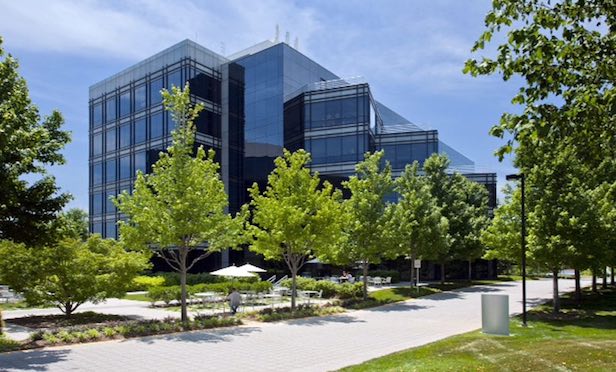 NAIOP headquarters in Herndon, VA; the association cautions that office absorption will come in lower in 2016. (Photo courtesy of Metro Offices)
NAIOP headquarters in Herndon, VA; the association cautions that office absorption will come in lower in 2016. (Photo courtesy of Metro Offices)
HERNDON, VA—As the outlook for GDP growth slackens, the office sector will start feeling the pinch. That sums up a new forecast from the NAIOP Research Foundation, which anticipates a sharp drop in net absorption compared to 2015.
The forecast from Dr. Hany Guirguis, Manhattan College, and Dr. Joshua Harris, University of Central Florida, predicts that the US office market will absorb approximately 34.6 million square feet of space in 2016, down from 62.1 million square feet last year. That’s in tandem with GDP growth slowing to 0.5% in the first quarter of this year and projected to achieve no more than 2% annualized growth for the next two years.
Absorption is expected at present to regain some strength in ‘17, totaling approximately 46.2 million square feet. “However, this figure could change, depending on how the economy fares throughout the rest of 2016,” according to the NAIOP Research report.
Overall, the report sees the nation’s economic condition as “more tenuous in mid-2016 than it has been in recent years. Low energy prices and a declining global economic outlook—due, in part, to European debt crises and a slowing Chinese economy—have finally had a measurable impact on the domestic situation.”
The biggest drag on the forecast comes from lower GDP expectations going forward and falling rates of nonresidential private fixed investment, which measures the willingness of private businesses to expand their productive capacity. Coming in second is the decline in corporate profits, which have been falling since Q4 of ‘15, “a reversal of a trend that bears watching and is a cause for concern, especially for the office sector.”
Until April’s reading, employment growth had been fairly steady over the past five years, but that month registered only 160,000 net new jobs. “This was well below the 200,000 jobs-per-month threshold considered the minimum necessary for sustained economic growth,” says Harris. Subsequent to the report’s preparation, the May job numbers reaffirmed the authors’ point, registering net gains of just 38,000. “We expect the overall declines in macroeconomic output to continue to result in lower employment gains for the rest of 2016.”
Office-using job sectors are forecast by Guirguis and Harris’ model to decline in their rate of growth as well, although the slowdown has yet to register in the available data. “We forecast that office-using employment gains will soften in 2016 as those sectors feel the impact of less macroeconomic activity. If the office sector manages to maintain its level of growth despite the economic headwinds, office absorption will likely be closer to the high end of the forecast range, which is 35.1 million square feet for 2016 and 49.1 million square feet for 2017. Indicators from the Institute for Supply Management Non-Manufacturing indices are not yet showing a decline, but we believe the falloff will come.”
Overall, “we are not yet forecasting a recession or significant downturn, just a flattening that should cause office demand to level off,” Guirguis and Harris conclude. “Further, since the economy has been growing slowly for the past several years, it is likely that there is not enough ‘overheating’ for a recession. If one were to occur, chances are it would not last very long or be very deep.
“Office markets do not yet appear to be overbuilt nationwide,” they add. “Therefore we do not expect significant negative impacts to the office property sector.” Still, they say, any reduction in net demand for office space is likely to soften rental rates and impact the bottom line of office investors and developers.
A newly issued Q1 report from Colliers International shows that at least in this year’s early stages, office fundamentals remain solid. It reports a 10-basis point drop in national vacancy to 12.6% from Q4 of ‘15, and projects an additional decline in vacancies for the current quarter.
However, the Colliers report also notes a moderation in absorption levels during Q1, as well as a 15% decline in investment sales, although that’s more a reflection of last year’s “record strength” than of weakening markets. “While sales volume decreased, pricing has remained elevated as the inventory of top quality assets available has diminished,” according to Colliers.

















 Copyright © 2024 ALM Global, LLC. All Rights Reserved.
Copyright © 2024 ALM Global, LLC. All Rights Reserved.